
Old injuries and chronic conditions can mean ongoing pain that is difficult to treat with over-the-counter medications or heat and ice packs. However, opioid use can be addictive and prove less effective as time goes by. More and more patients are finding relief from natural, safe, PRP therapy - a treatment that uses your body’s own natural healing mechanisms to help regenerate damaged tissues and relieve pain.
What Is Platelet-Rich Plasma (PRP)?
Blood is made up of red cells, white cells, and platelets in a plasma base. Platelets are important for blood clotting, but also contain hundreds of proteins called growth factors, which can be extremely helpful in the healing of injuries.
Platelet-Rich Plasma, or PRP, can be created from your own blood in your clinician’s office. It involves withdrawing one or more vials of blood and centrifuging them to concentrate the platelets in the plasma. The now “platelet-rich” plasma is injected back into your body at the site of your pain.
How Does PRP Work Against Pain?
When PRP is injected into the site of pain or inflammation, the growth factors can kick start your body’s natural healing mechanisms, going to work to repair damaged tissue and restore normal function. As inflammation goes down, the pain relief kicks in, and you can move without the tightness and pain caused by internal pressure and swelling. PRP therapy is a good option for patients for whom other methods, such as steroid injections and oral pain relievers, have failed.
What Conditions Can PRP Treat?
PRP is commonly used for joint or tendon pain caused by an acute injury or by overuse. It has been found effective in managing pain due to osteoarthritis of the knees, as well as for chronic low back pain caused by degenerative disc disease.
Our board-certified physicians primarily recommend PRP therapy for the management of joint pain. Your pain management specialist will draw your blood, spin it in the centrifuge to obtain the platelet-rich plasma, and inject the PRP directly into the joint capsule.
An ultrasound or other imaging system may be used to ensure precise placement of the injection, and you may need several injections to achieve the desired result. The whole process generally takes only one to two hours, and pain relief from PRP can last for several months after your injection.
Precision Pain Care and Rehabilitation has four convenient locations in Richmond Hill – Queens and New Hyde Park, Lindenhurst, and Valley Stream – Long Island. Call the Queens office at (718) 215-1888, or (516) 419-4480 for the Long Island offices, to arrange an appointment with our Interventional Pain Management Specialist, Dr. Jeffrey Chacko.















